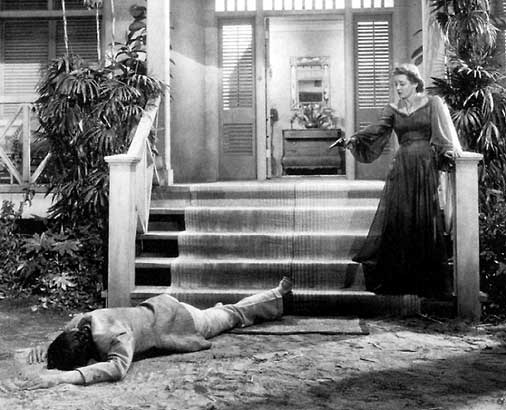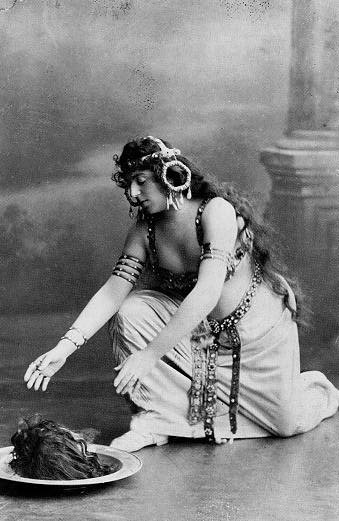One of the other things I did during last week’s trip to Washington, D.C., was attend a reception for Richard Gaddes, the Santa Fe Opera’s recently retired general director, who was in town to receive an NEA Opera Honor. I chatted with several members of the Santa Fe Opera board about The Letter, which Richard commissioned. All were amazed and delighted when I told them that The Letter is only ninety minutes long. One of the men to whom I spoke didn’t know that our opera is based on the same Somerset Maugham play that William Wyler filmed in 1940. “A Bette Davis opera?” he said. “And it’s only an hour and a half long? You can’t miss!”
Needless to say, there’s no such thing as a can’t-miss opera, but I knew what he meant, as well I should have: we planned it that way, right from the start.
In August of 2006, a few days after I first suggested that Paul Moravec, my collaborator-to-be, read “The Letter,” the short story that Maugham later adapted for the stage, with an eye to turning it into an opera, Paul wrote back to me as follows:
First impression: top-drawer, rattling good stuff, ripping yarn. I see it as a 90-minute, no-intermission opera (à la Wozzeck).
Later that day he sent me a second e-mail:
Further ramblings on why an opera plot should just go as inevitably and irresistably as a locomotive: in the absence of such a plot, it seems that the composer has to work too hard just to make his music overcome natural inertia. Dramatic music requires the vehicle of such a plot to ride on and through from beginning to end. It involves the nature of time itself: if the time-sense is thick and viscous and boring, so is the effect of the music, no matter how brilliant it may be. As the time-sense of the narrative goes, so goes the time-sense of the music. It is a deeply poetic medium, not at all prosaic, and, for example, the dragging effect of too much detailed prosaic exposition, too much contemplative commentary, too much character elaboration, etc., is just death.
 By then it was already clear that we were thinking along the same lines, if from slightly different angles: Paul was thinking like a poet, I like a craftsman. (That sums us both up pretty well.)
By then it was already clear that we were thinking along the same lines, if from slightly different angles: Paul was thinking like a poet, I like a craftsman. (That sums us both up pretty well.)
The next day I replied:
Here’s the opening: house to black. The orchestra plays three or four Tosca-like prefatory chords. Then, in total silence, we hear six gunshots in the darkness. Lights up fast on Leslie standing over the dead body of her lover, holding a smoking revolver.
BOOOOOOOM!! Is that an opera, or what?
And yes, you’re totally right—the model is Wozzeck and it should play without an intermission.
Within a few days I’d refined the opening gambit—the gunshots now came first, followed by the music—and shortly thereafter the two of us started talking face to face and in detail about we wanted to do.
Three months later we sent an outline of The Letter to Richard Gaddes, accompanied by a letter in which we jointly explained what we had in mind:
We see The Letter as a cross between a musical film noir and a verismo opera, smaller in physical scale than Tosca but similar in weight and intensity. We want it to feel like a movie, which is why we plan for it to run roughly ninety minutes without an intermission, with orchestral interludes bridging the scene breaks. Our goal is to write an opera whose casting and scenic requirements are compatible with the needs of medium-sized regional houses but which is musically “big” enough to work just as well in large houses.
Ten days after that, Gaddes sent us the simplest and most thrilling of replies: “We are planning to proceed with the commission of The Letter for 2009.”
 What this correspondence makes clear is that from the very outset of our collaboration, we knew exactly what kind of opera we wanted to write. In addition to Tosca, Paul had in mind Alban Berg’s Wozzeck, while I was thinking more of Richard Strauss’ Salome, Benjamin Britten’s The Turn of the Screw, and Gian Carlo Menotti’s The Medium, but all of these works are concise, fast-moving, and melodramatic in the best sense of the word.
What this correspondence makes clear is that from the very outset of our collaboration, we knew exactly what kind of opera we wanted to write. In addition to Tosca, Paul had in mind Alban Berg’s Wozzeck, while I was thinking more of Richard Strauss’ Salome, Benjamin Britten’s The Turn of the Screw, and Gian Carlo Menotti’s The Medium, but all of these works are concise, fast-moving, and melodramatic in the best sense of the word.
At the same time, the initial conception of The Letter was influenced as much by cinematic models as by operatic ones. We had talked early on about the possibility of writing a Raymond Chandler opera, and Paul also suggested that Casablanca would make a perfect libretto. I nipped those ideas in the bud, knowing that we could never get the rights to adapt Casablanca or any of the Chandler novels that have been filmed (i.e., most of them). But the idea of writing a film-noir opera was still very much in our minds when I suggested “The Letter” to Paul.
That’s why we decided to stick with Paul’s initial impulse and write a ninety-minute opera with no intermission.
No doubt certain spinach-pushing critics will jump from there to the conclusion that The Letter is unserious, but that’s their problem, not ours. Paul and I believe that it’s possible for an opera to be both popular and serious, like Tosca or Salome or Rigoletto. Or Sweeney Todd, for that matter.
In the ever-relevant words of Louis Armstrong, “Showmanship does not mean you’re not serious.” We’re dead serious—but The Letter is still a show.
